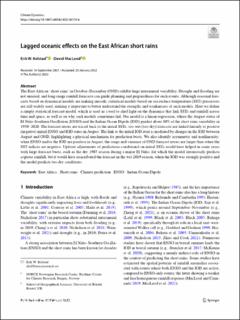| dc.contributor.author | Kolstad, Erik Wilhelm | |
| dc.contributor.author | MacLeod, David | |
| dc.date.accessioned | 2022-06-14T07:22:30Z | |
| dc.date.available | 2022-06-14T07:22:30Z | |
| dc.date.created | 2022-05-23T09:17:46Z | |
| dc.date.issued | 2022 | |
| dc.identifier.citation | Climate Dynamics. 2022, . | en_US |
| dc.identifier.issn | 0930-7575 | |
| dc.identifier.uri | https://hdl.handle.net/11250/2998608 | |
| dc.description.abstract | The East African ‘short rains’ in October–December (OND) exhibit large interannual variability. Drought and flooding are not unusual, and long-range rainfall forecasts can guide planning and preparedness for such events. Although seasonal forecasts based on dynamical models are making inroads, statistical models based on sea surface temperature (SST) precursors are still widely used, making it important to better understand the strengths and weaknesses of such models. Here we define a simple statistical forecast model, which is used as a tool to shed light on the dynamics that link SSTs and rainfall across time and space, as well as on why such models sometimes fail. Our model is a linear regression, where the August states of El Niño-Southern Oscillation (ENSO) and the Indian Ocean Dipole (IOD) predict about 40% of the short rains variability in 1950–2020. The forecast errors are traced back to the initial SSTs: too-wet (too-dry) forecasts are linked linearly to positive (negative) initial ENSO and IOD states in August. The link to the initial IOD state is mediated by changes in the IOD between August and OND, highlighting a physical mechanism for prediction busts. We also identify asymmetry and nonlinearity: when ENSO and/or the IOD are positive in August, the range and variance of OND forecast errors are larger than when the SST indices are negative. Upfront adjustments of predictions conditional on initial SSTs would have helped in some years with large forecast busts, such as the dry 1987 season during a major El Niño, for which the model erroneously predicts copious rainfall, but it would have exacerbated the forecast in the wet 2019 season, when the IOD was strongly positive and the model predicts too-dry conditions. | en_US |
| dc.language.iso | eng | en_US |
| dc.rights | Navngivelse 4.0 Internasjonal | * |
| dc.rights.uri | http://creativecommons.org/licenses/by/4.0/deed.no | * |
| dc.title | Lagged oceanic effects on the East African short rains | en_US |
| dc.title.alternative | Lagged oceanic effects on the East African short rains | en_US |
| dc.type | Peer reviewed | en_US |
| dc.type | Journal article | en_US |
| dc.rights.holder | © The Author(s) 2022 | en_US |
| dc.description.version | publishedVersion | en_US |
| cristin.ispublished | true | |
| cristin.fulltext | original | |
| cristin.qualitycode | 2 | |
| dc.identifier.doi | 10.1007/s00382-022-06176-6 | |
| dc.identifier.cristin | 2026331 | |
| dc.source.journal | Climate Dynamics | en_US |
| dc.source.pagenumber | 14 | en_US |

